May 2014 April 2014 >>
Blog of Jack and Jude
explorers, authors, photographers & videographers
Safe in South Australia
Banyandah has successfully sailed across the Australian Bight once again, and although we suffered gales, calms and winds from all directions, Jack and Jude have arrived safe in South Australian waters without injury or breaking any gear on our ship. For this we feel especially thankful.
We first anchored behind Cape Catastrophe, where after a celebratory cooked breakfast and a wee bit of time to savor our surroundings, we pushed on to Port Lincoln. And now that we are safe in calm waters we’ll write a complete account of our wonderful time at Daw Island, the gale that drove us out, and our 600 mile voyage across the Great Australian Bight.
May 16th – In Heaven
Imagine the silence and stillness of deep space, its total absence of movement and sound creating an ambience of bliss so welcome after months of southern ocean rocking and pitching with wind and sea noise always a part of life. Hidden inside Spalding Cove with Port Lincoln in sight, we have found heaven after our Bight crossing. Lazily awaking after a second celebration, we floated in bed, dozing, cuddling, reminiscing the highlights of our very successful Southern Ocean crossing while out through the open companionway a perfect blue sky occasionally flashed with a family of swallows darting about our decks and rigging, their faint chirping our only sounds.
We are both so delighted that we didn’t spit the dummy a few weeks ago when the continually overcast and showery conditions and washing machine ocean encountered around Esperance kept us boat bound and had Jack thinking of sailing directly for South Australia. But we pushed on hoping for a unique experience.
Middle Island in the midst of the thousand islands making up the Recherche Archipelago was showery and windy. Only our first morning did we paddle about Goose Island enjoying a great time photographing the dramatic scenery and wildlife. But we never walked nor touched the soil of either Goose or Middle islands. Even though Jack googled a route to Pirate Black Jack’s secret bay, the weather never gave us the chance. Too many rain events and a challenging swell to land stopped us leaving our ship. Not surprisingly other interests kept us busy.
Then at first light after conditions mellowed, we got underway for Daw Island, the last island in the group and final stop before facing the Bight.
 Guess you’ve never heard of this out of the way bit of land that pops up from the turbulent southern ocean twenty miles from Isrealite Bay. We had sailed past it five miles off when on our way west one year, but we had wind for many more miles and settled that night behind Bellinger Island where we received a welcoming gift of a fresh lobster from a lone fisherman. So, this time, we were especially keen to explore Daw Island and more so after Ted, our ex-tuna fisherman friend in Albany had told us that Daw Island once had a tuna processing ship stationed there during the fishing heyday of the 70s.
Guess you’ve never heard of this out of the way bit of land that pops up from the turbulent southern ocean twenty miles from Isrealite Bay. We had sailed past it five miles off when on our way west one year, but we had wind for many more miles and settled that night behind Bellinger Island where we received a welcoming gift of a fresh lobster from a lone fisherman. So, this time, we were especially keen to explore Daw Island and more so after Ted, our ex-tuna fisherman friend in Albany had told us that Daw Island once had a tuna processing ship stationed there during the fishing heyday of the 70s.
 Today Daw Island is a Nature outpost, a lonely island at the very eastern end of the remote Recherche Archipelago, impossible to visit without a stout vessel and the courage to face Australia’s south coast. Very few visit, mostly fishermen and a few yachtsmen, but hardly any tinny/pleasure boat fishers venture that far from help.
Today Daw Island is a Nature outpost, a lonely island at the very eastern end of the remote Recherche Archipelago, impossible to visit without a stout vessel and the courage to face Australia’s south coast. Very few visit, mostly fishermen and a few yachtsmen, but hardly any tinny/pleasure boat fishers venture that far from help.
Wild creatures live on Daw. Cute, comical sea lions, majestic sea eagles, plump geese, muttonbirds, penguins, and deadly snakes all coexist with a myriad of other birds and critters that are not inconvenienced by man and his needs. At Daw, these creatures raise their families unmolested, far removed from the human specie. At Daw, Nature dominates. And that makes Daw special.
In our adventure machine we have traveled far and wide to find Nature living as if man does not exist. Last year we sailed to the middle of the Coral Sea to observe thousands of sea birds undisturbed by man. This time we pitted our skills to sail the ocean that can often create gigantic waves from storms gathering their fury in the freezing waters near Antarctica. Down here under Australia, far away from the built up centres of Albany and Esperance, there are a thousand islands, some just rocks partly submerged but still home for so many creatures.
The distance from Middle Island to Daw required us to sail on first hint of light. Jack slept lightly and arose to ready the ship while still in darkness. His main chore, to download the latest seven day weather information from the internet as we’d be loosing contact upon leaving. All went perfectly until we attempted to raise our Boss anchor. Our chain straight up, the winch could not budge it another inch. With daylight fast increasing, his frustration erupted, using power he maneuvered the ship’s bum to shore in an effort to tease our ground tackle out backwards. But that failed in a sickening series of dips when all pulled up horribly tight.
Not for years have we jammed an anchor like this. Why on this day when we needed every minute of daylight! But like so many things in life, one moment frustrating drama, the next all free and easy. A note to the Boss makers, it wasn’t a stuck anchor, but our chain wrapped around rock.
Our sail to Daw was perfect. We altered course often to dodge rocks and tiny islands jutting out the ocean and we were somewhat frightened and in awe when great swells rolled then broke over underwater shoals we couldn’t see. But the wind held and forty miles on Daw became visible as a dull grey shadow with white water flashing high into the sunlight. After sailing forty-eight miles and still flying full sail, we were conning our way into calmer water, Jack atop the coach house searching for hidden dangers. Daw Island, shaped like a boomerang has tall massifs, but is not surveyed. Its sister island, New Year, is only marked by a pinprick on navigational charts. Before us the sun lit up bright red, yellow, and orange colours of succulents.
Sunday 4th May – First exploration
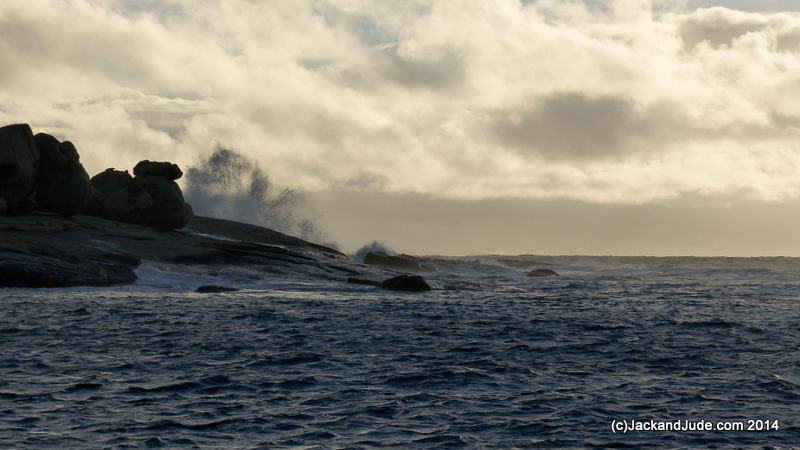 Jack and Jude have been so fortunate to have paddled the Green Machine around this Nature outpost and watched impressive forces attack the land. Every minute powerful swells were exploding somewhere against Daw’s solid rock before erupting into a plume of spray, or sending waves sweeping up smooth rock fronts to where sea-lions rested unconcerned.
Jack and Jude have been so fortunate to have paddled the Green Machine around this Nature outpost and watched impressive forces attack the land. Every minute powerful swells were exploding somewhere against Daw’s solid rock before erupting into a plume of spray, or sending waves sweeping up smooth rock fronts to where sea-lions rested unconcerned.
Donning thick walking pants, boots, and wet weather gear after landing on the only sand beach we straight away noticed a sign warning of deadly snakes. We know about these creatures, so Jack took the first track thorough the shallow bush that lead to another and another until we reached the saddle looking both to windward and into our anchorage. The Banyandah looked so impressive all alone in her half caldron while the weather side showed occasional white caps on a grey sea under a sludgy grey sky filled with moving clouds that drew our attention to approaching black curtains of rain. But, feeling the invigorating fresh breeze fired up our desire to reach the island’s highest peak and along the way our cameras captured gigabytes of this beautiful Earth and our moments upon it.
Rain came just as we reached a rock cave near the end of the main island, and ducking under its crude cover we watched several Cape Barren Geese honk and gesture while trying to figure us out.
 High overhead a pair of majestic sea eagles soared as if they owned the sky, they were using Nature’s forces to swirl and look down on everything like the very best spy camera. What a life. No bills to pay. No bureaucratic red tape. Mating for life and sharing the same hunting range, in the morning and evening they roost and sing together, at other times soaring on earth’s energy, maybe spotting a tasty treat, their super sharp talons piercing and lifting huge fish from the sea. They are indeed a talented unique creature.
High overhead a pair of majestic sea eagles soared as if they owned the sky, they were using Nature’s forces to swirl and look down on everything like the very best spy camera. What a life. No bills to pay. No bureaucratic red tape. Mating for life and sharing the same hunting range, in the morning and evening they roost and sing together, at other times soaring on earth’s energy, maybe spotting a tasty treat, their super sharp talons piercing and lifting huge fish from the sea. They are indeed a talented unique creature.
White-bellied Sea Eagles, Australia’s second largest raptor after the giant Wedge Tail Eagles, is listed as Threatened in Victoria and Vulnerable in South Australia and Tasmania. Their main threat, human disturbance to its habitat, both from direct human activity near nests which impacts on breeding success, and from removal of suitable trees for nesting.
The adult White-bellied Sea Eagle is a distinctive bird with its white head, breast, under-wing coverts and tail. Their upper parts are grey and the black under-wing flight feathers contrast with the white coverts. Like many raptors, the female is slightly larger than the male, and can measure up to 90 cm (35 in) long with a wingspan of up to 2.2 m (7 ft), they weigh 4.5 kg (10 lb). Their call, a loud goose-like honking.
After the shower passed, Jack eagerly pushed up the last ridge connecting the two peaks with a part of that route following a rock ledge that fell sharply into the sea. That might prove dangerous for Jude’s wonky knee, so she took a higher route through scrub where upon putting an un-gloved hand down for support, a coiled snake struck at her. You can imagine her fright. Daw Island is a long way from help.

Tuesday 6th May – Preparations
 We’ve been busy today, non-stop packing Banyandah for her battle with the oncoming “vigorous cold front” rushing towards us at thirty knots. A gale warning has been issued for Cape Leeuwin and we’re hoping that we’ll not be hit as hard as the forty knot winds predicted for Australia’s southwestern point.
We’ve been busy today, non-stop packing Banyandah for her battle with the oncoming “vigorous cold front” rushing towards us at thirty knots. A gale warning has been issued for Cape Leeuwin and we’re hoping that we’ll not be hit as hard as the forty knot winds predicted for Australia’s southwestern point.
A battle plan has been drawn up. We’ll leave tomorrow when the wind turns to the north or the sun starts to set, whichever comes first. We cannot stay at Daw tomorrow night because during that night the wind will swing and enter this bay and by early the following morning the front will strike and before it will come strong wet winds from the northwest that will enter this bay bringing wild conditions. Best to be at sea, with nothing but open space and deep water around. Then even if it gets really bad, bucketing rain and howling, we have options like hove to.
That first night we’ll sail due east, trying not to lose latitude and be forced into the more vicious winds. And then at daybreak after the front hits, we’ll hunker down with just two tiny sails up forward, the mainsail lashed tightly to the boom. That’s when we’ll head a bit more southerly, towards Investigator Straits because after the front a longish high pressure system will move in producing variable winds in the north of the Bight and mighty fine sailing conditions further south. That’s the plan. Let’s see how it turns out.
Tuesday 7th May – Waiting
Another 24 hours has past since writing the above and we are still anchored at Daw Island with upwards of twenty-knot winds coming over the sugarloaf. Going out into that would force us to lose latitude and push us further into harm’s way. So we’ve opted to stay put until forced out. When might that be is being seriously studied from the weather charts coming over our radio fax. The Cold Front has yet to reach Cape Leeuwin, but we know the wind will back NW before the front. The anchorage at Daw is not recommended for anything further around than NE, but we’re sort of hoping the anchorage will stand a bit of north. To the NW is wide open, so we’ll have to be gone before the wind swings that far. Probably much sooner than that. But going out into twenty knot headwinds would mean we’d have to haul up tightly on the wind, putting ourselves and our lady under a lot of stress. Better to hang here and go out in the dark if need be.
Yesterday we packed away the kayak, putting the two main stringer frames into one bag and all the bulkheads, seats, backrests, and footpads in the starboard cockpit locker. Its Hypalon skin was folded into a neat bundle then taken below where Jude lashed it on top of the forward bunk along with the two paddles.
Little Red has its own emergency bag containing water, food, a medical kit, and fishing gear and of course signalling flares. Some while ago Jude made a stout bag for those items that ties the bundle under the centre seat. The oars we lashed to the seats as well.
Down below everything loose found a home. Jude made two loaves of bread and a nice tub of coleslaw. Amazingly yesterday was mostly bright and sunny, so she also washed our dirty cloths, and rinsed the salt out our kayak clobber so it could be put away.
After that busy day’s work we enjoyed a libation or two then enjoyed a fried fish dinner. The fishing in this bay has been excellent. We can see squid in formations near the bottom, but Jack’s bait attracted two small trevally that when fried with ginger and chilli tasted heavenly.
It’s pasta tonight and then a nervous wait for the wind to shift. On the weather reports we have heard this storm is rather gusty and so setting too much sail might create a big problem. Jack is thinking of going up to rearrange our reefing lines so he can put in the third reef. Our boom accommodates only two reefing lines which are normally set in the first and second reefing cringles. He’ll move the reefing line from number one up to the third cringle.

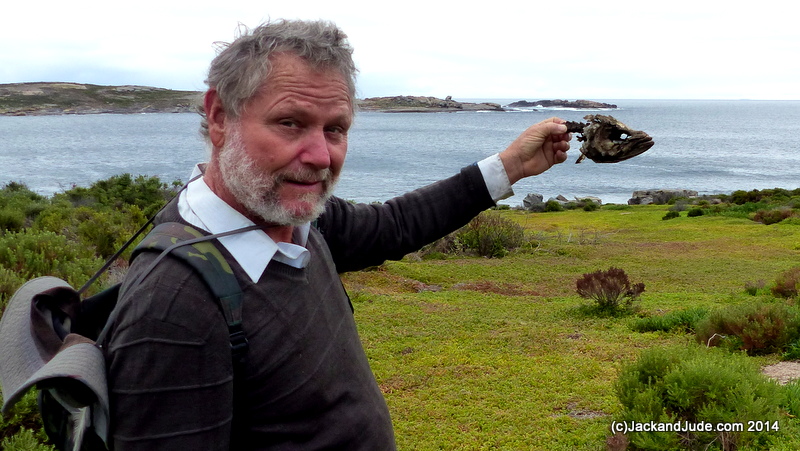
Skeleton amongst the succulents – All that remains from a Sea Eagle Supper
Wednesday 8th May – Our voyage begins
As darkness fell upon the sparsely clad islands forming this Nature stronghold, a few seal pups were crying for a feed while the honking of Cape Barron Geese echoed off the towering rock sugarloaf. Those massifs still held back the real wind from our anchorage, but that would shortly change. When? In the dark night or with morning light, it was impossible to know. We only knew that when the wind found its way into our bay, we must be ready to leave in haste, fearing it might come in strong gusts.
Jude made the wise move of going to bed soon after darkness fell, while Jack waited for the 8:30 weather report. He wanted to hear what wind strength the other stations would report so he could better judge when the change might reach us. He lay on the sofa listening to the wind rustle the bay’s waters and waited, fighting off edginess and fatigue by popping up topsides every few minutes to confirm that that wind still stole down over the massif that stood as a dark silhouette before us. When the 8:30 report told him little new, he chanced a lie down next to his sleeping wife, leaving his clothes on with the thought that he’d then only sleep lightly.
Several times in the next hour Jack arose to check the wind, but it still came from the sugarloaf. Thus calmed, he must have nodded off for next he knew Jude was climbing over him to check the wind. When she returned, she almost casually mentioned that the wind was now rather light and stealing into our bay from the open gap. Nearly leaping from bed, it took but a moment for Jack’s eyes to accustom themselves to the darkness and see his ship’s bow now facing an unbroken starry horizon well past north. The time was 11:00PM.
“Time to go,” came out hoarsely and from bed, Jude threw back the covers and began dressing in warm jumpers and wool track pants.
By the time she arose, adjusting her wool beanie, Jack had the engine ticking over and our instruments alight. The wind had subsided to a mild breeze perfect for picking up our anchor in the dark and with a hot drink warming us, we set to work getting Banyandah ready for sea with well practiced ease. Jude drove while Jack retrieved the anchor, followed by the more challenging task of navigating out of the rock bound bay which was not shown on our charts, and therefore not showing on our GPS. But we had our track in and skills enough to guide us out. Jack on the foredeck well away from blinding lights, searching the dark horizon for the smaller rock island that guards Daw’s entrance.
Jude at the helm, engine just ticking over in forward gear making way at a little over four knots. In fact the easy wind made our task fairly easy, and only once did we spy the deadly white of breaking surf while feeling our way around those islands into open sea. As we cleared the islands, the wind strength increased, allowing us to silence the engine and sail on without mechanical sounds. And then quite soon Banyandah was slipping through those dark waters towards South Australia while Daw Island merged into the night.
With Sir Aries now steering our ship and a fair breeze driving us towards open waters, the time an hour after midnight, Jack relinquished command and toddled off to our now rocking bed.
It rained during Jude’s early morning watch, and at first light our world was devoid of all but grey overcast light. The wind had found its feet pushing Banyandah along at a brisk pace accompanied by increased swell and motion. Jude was knackered. One quick kiss sent her to bed. Although the wind had stay in the north, the barometer had falling to 1005 mb indicating that the front approached. How severe would it be? The forecast had indicated gale force winds for all the south coast, one report indicated destructive winds and hail.
In preparation for running before storm winds, Jack setup our running backstays so we could raise both headsails and lower our main. That is our normal sail plan in storms. The two sails forward pull the ship, allowing Sir Aries a better chance of steering us straight and true down the increasing waves.
While Jude slept aft, from under the cover of our dodger Jack watched the thick heavens drop heavy raindrops. He had promised to keep dry and had gone to the trouble of donning full wet weather gear, tight as it was. It seems the passing years had shrunk his kit!
Most fronts bring an abrupt wind shift when the warmer air that has been lifted by the cold air passes overhead, usually abruptly changing the wind from a northerly to a west or southwest wind in a blink. But this front didn’t have an abrupt change. It just slowly backed as the clock ticked on. Menacingly, each minute seemed to bring it a bit more power.
Jude was well awake and making a hot soup lunch when we spied a line of blue sky astern, grey clouds before, black rolls following. It seemed to take all day for that brilliant blue to catch us, by which time our barometer had fallen to 1004 mb and the wind had backed to the west, allowing us to set the twin headsails and lower and lash the mainsail. Under this rig we rolled heavily and sudden violent flips side to side were accompanied by spray blown off wave tops with occasional blue water crashing over our aft deck. Nature’s noise almost deafening.
After rigging the sails, Jack setup the hammock aft and wearily climbed in hoping for some rest. But his mind kept ticking over the words of the last weather report that had indicated hail and destructive winds. Cape Leeuwin had reported gusts of 45 knots. And so he lay in quiet repose, rocking side to side until a green wave hit and gushed through an aft porthole wetting our bed. This had to be fixed or we’d get very wet below, so he put his mind to the task of finding a way to seal a hatch that was already fully tightened. Spreading thick Lanolac grease on the seal line from outside might close the gap, but that would require chancing a severe wetting. Nevertheless his mind played out the moves, readying the needed equipment in his head. After much time dwelling on this approach, he noticed two screws on the porthole’s rim adjacent to the offending leak and his mind’s eye saw that a bracket secured by longer screws using those positions would pull the porthole tighter. For the next hour while he rocked in the hammock, his fatigued mind metaphorically assembling the tools and supplies, and noting that he must first verify that we had the extra long screws in store.
A strange event came with the passing of the front in that the thickly clouded sky became cloudless although the wind increased and became violently gusty, turning wave tops into horizontal spray. With less than an hour of light remaining, Jack arose from his swinging bed and in a well planned move instigated his plan of repair on our leaking porthole. The next green wave proved its success.
Day two of our crossing the wind eased to a mild breeze and veered north allowing us to reset all sail to make fair miles in the lumpy left behind sea. By day three, the cloudless sky brought ideal conditions for an easy passage with the night sky carpeted with stars and a waxing moon growing ever brighter. Only the last hundred miles gave us any hardship when our gentle breeze increased to nearly a strong wind that veered till we had all sails in tight. Crashing through wavelets, a few washing our foredeck making sleep hard to find amongst the swooping and diving as Banyandah charged through the attacking head seas.
Then came the crowning moment when the rising sun directly ahead lit the sky red artistically in layers each a darker shade down to a odd black shape that was South Australia rising from the sea with the sun. No matter how many landfalls we make, each is special. Once again, working as a team we had overcome the hardships and dangers to achieve our dream. With thankfulness filling his heart, Jack looked up and smiled while a pair of graceful albatross glided past his ship. Like twin brothers canvassing their world, they swung in unison to lock eyes with these other creatures sharing their world.
We’re off for Daw Island then bound for South Australia
Saturday, May 3rd
Probably loose contact until we come out in South Australia. Leave Daw Next Friday for 600 mile sail to Port Lincoln, or 750 mile straight through to Adelaide. Bye for now.
Star Night
Stellarium has been fired up tonight to help us identify the planets and the constellations that blaze above us in the darkening sky. Without a single manmade light for possibly a hundred kilometres our night sky is as clear as those viewed by Earth’s earliest inhabitants.
Jupiter showed early even though it followed closely behind the setting sun. Around in the east in a similar orbit, Mars’ red twinkle decorated the darkness behind our ship. Soon followed the stars making up Orion’s belt and above them more south was the Southern Cross with Rigel Kent and Hadar pointing to Gacrux, the cross’s top star.
Unseen in the star lit darkness, penguins trill, as well as a shrill call of an unknown creature. Why do they call?
The stars connect us to the Earth’s earliest inhabitants who imagined stories to explain what they did not understand, and through the ages man has studied and used the heavenly bodies to navigate. But do you know any of the lore or even the names of these heavenly bodies. Do you even have the time or the inclination to gaze up at the wonders of the universe? Is it all you want after a hard day’s work to veg out in front of a manmade drama?
It’s a pity succeeding generations shut out more of the real world, surrounding themselves instead with a manmade artificial one and make further changes to our society that enhances life in isolation. We think we are fashioning a world of our own making, instead we are destroying the real world.
Jack believes that Earth is God, and that God is Earth, creator of all life. He thinks if we accept this belief, our life’s journey will be a golden experience.
Read more April 2014 >>





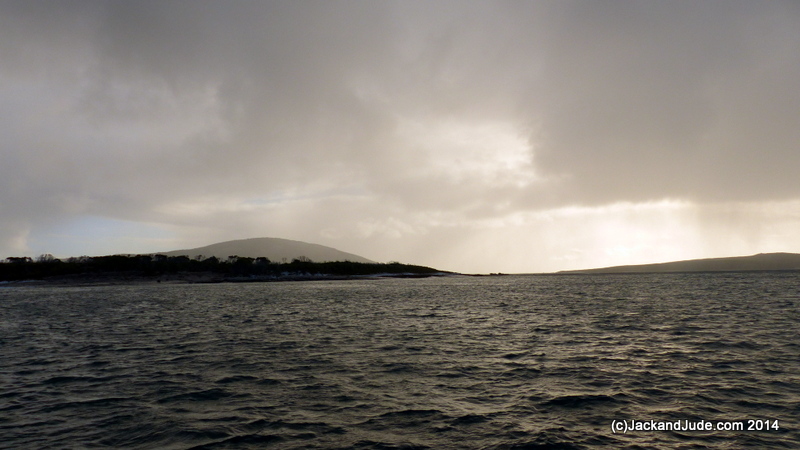
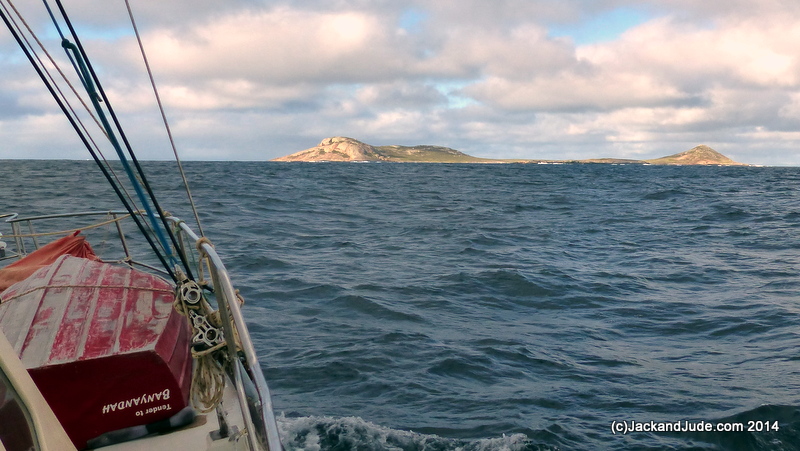
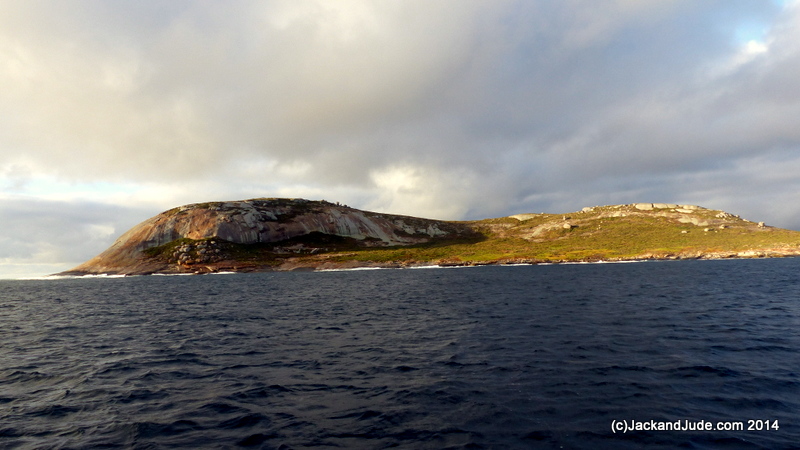
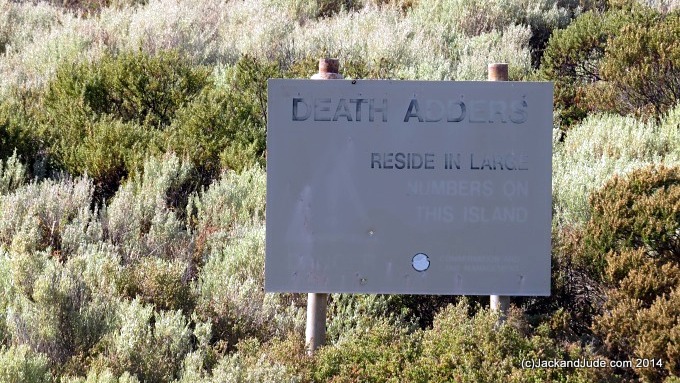
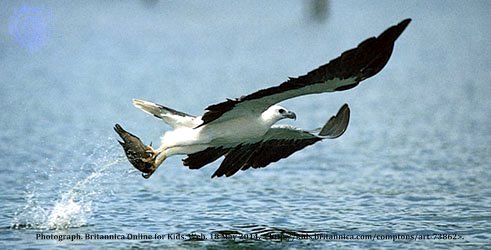
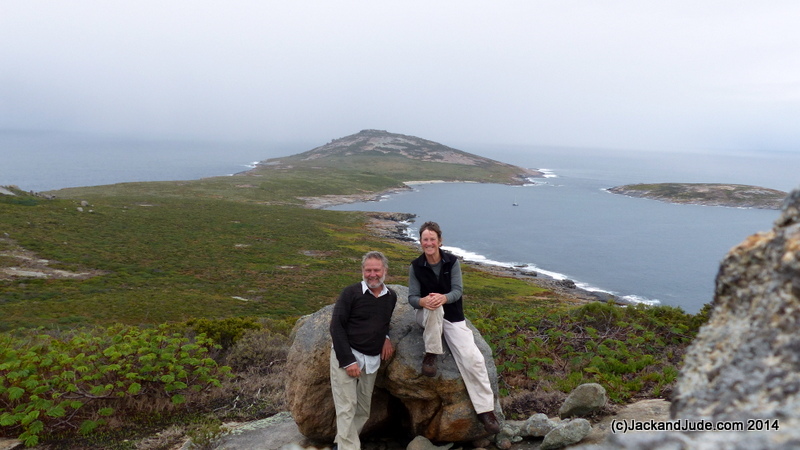


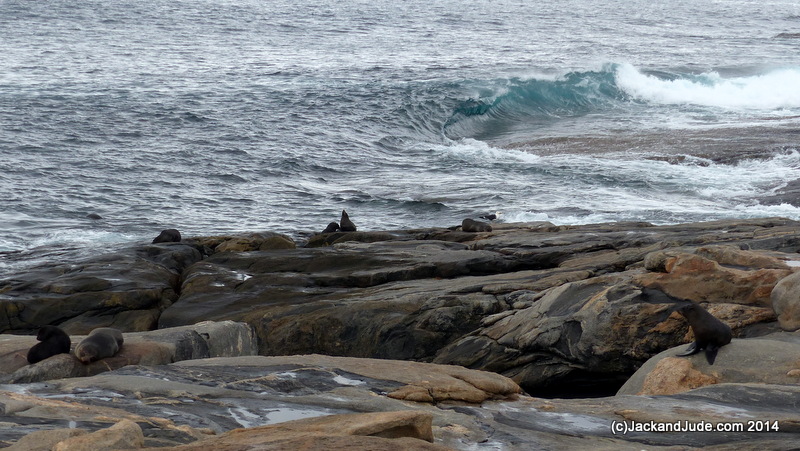
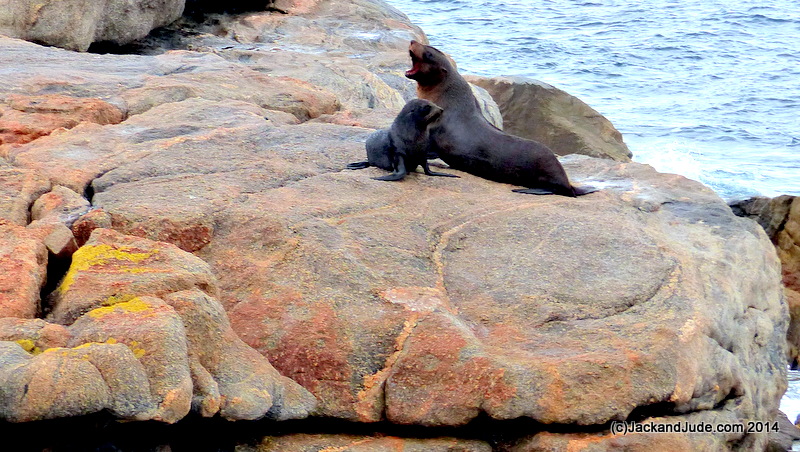
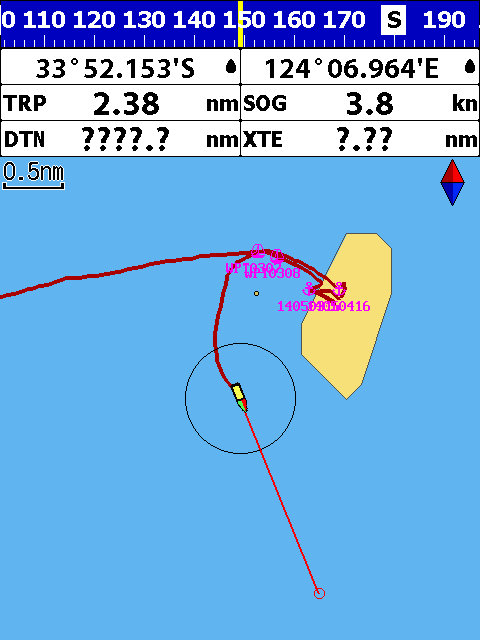

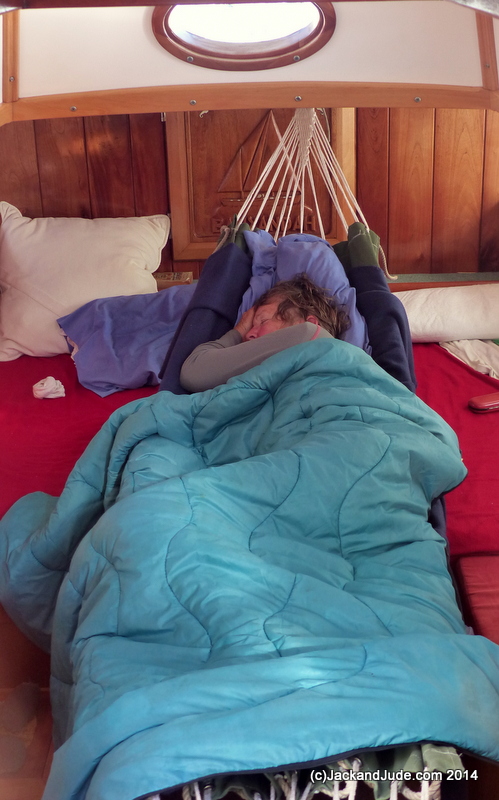
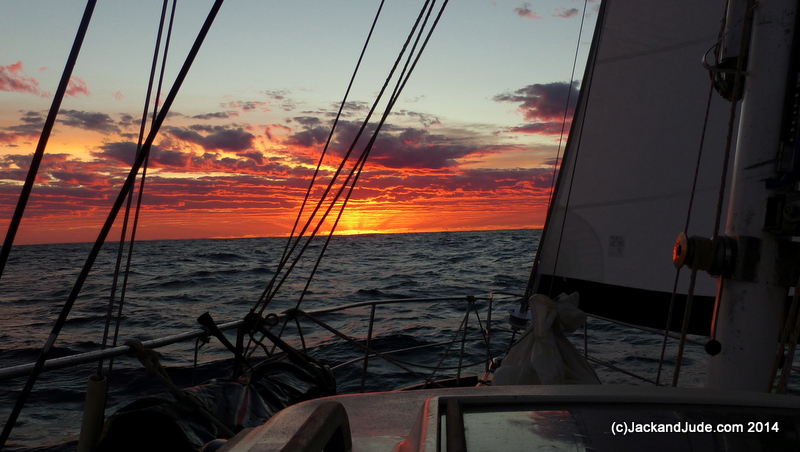
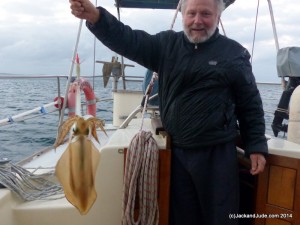

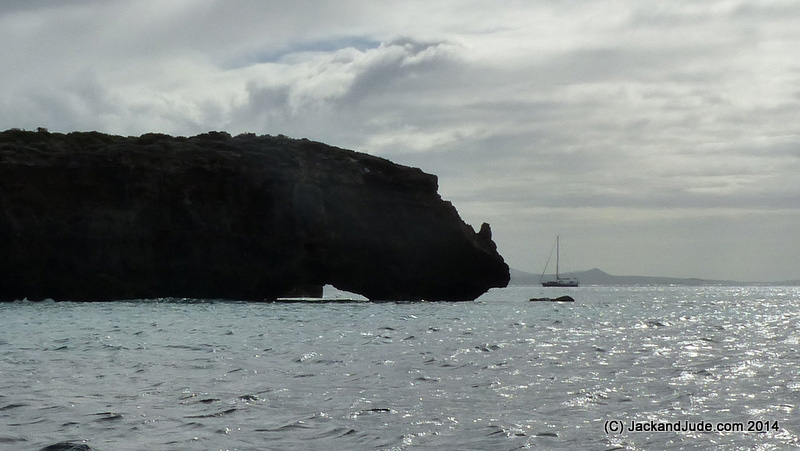
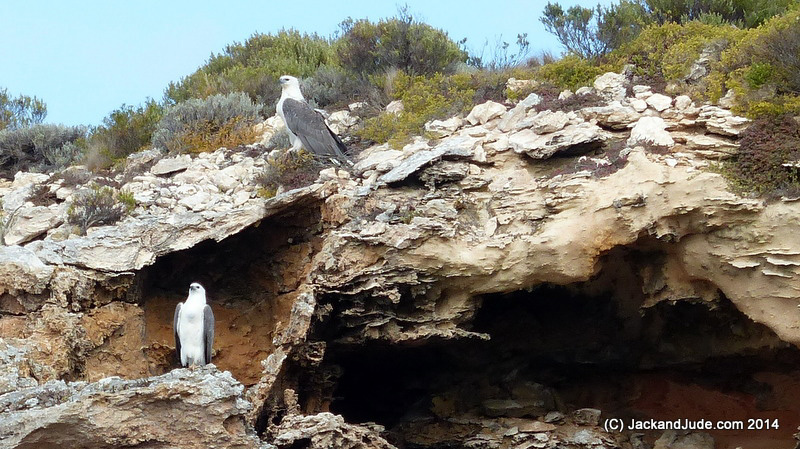
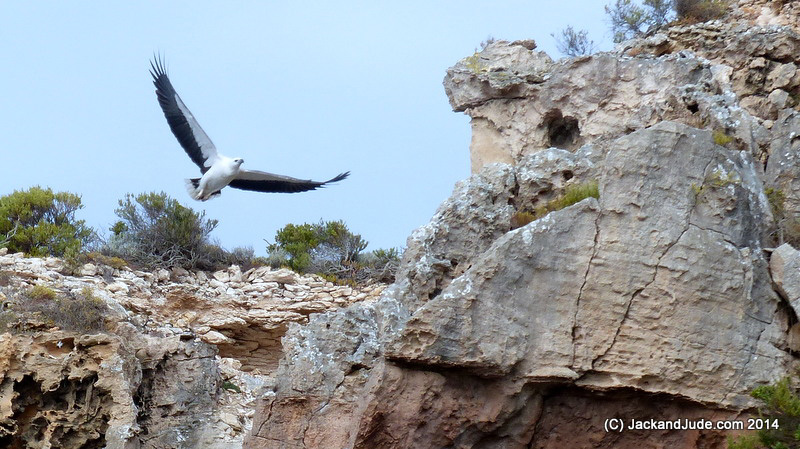
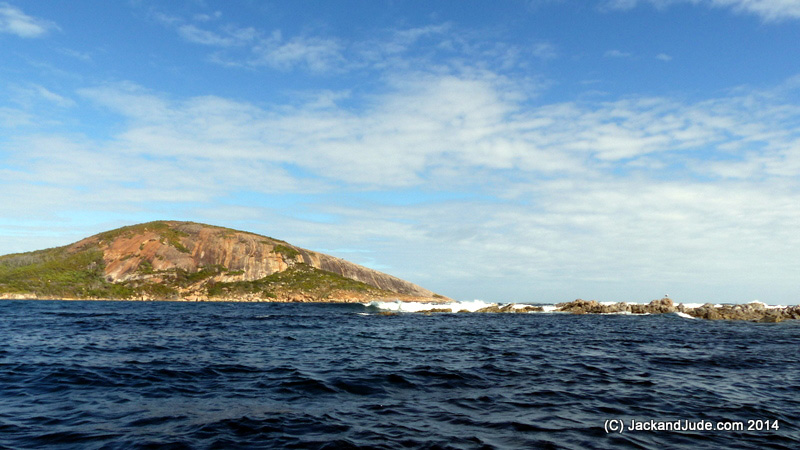
You Guys are amazing with your sailing experiences. I was particularly interested in your Daw Island stopover before you crossed the Bight. My Macgregor 26M has taken me to quite a few of the many isles of the Recherché Archipeligo, mainly within about 50nm from Esperance. Like you described they are awe inspiring granite ecosystems pretty well untouched. Sandy Hook is one of my favourites, as it has a beautiful sandy beach, well protected from anything from a northerly to a southerly, which are the ones to watch in this area as you say. If the easterlies are annoying, its easy to shoot over and tuck up behind Cape le Grand. I am planning to do a bit of a long haul (for me) across from there to Middle Is, then onto Daw. Should make for an interesting couple of weeks and your account of this area gives me more inspiration to get organized and do it. Regards Kelvin.
Jack and Jude
Brings back great memories of sailing into Daw Island escorted by sea lions in 1987. We sailed on the “Spirit of Esperance” a cataraman built and owned by Tony O’Brien after whom O’Brien’s Bay is named.
I don’t recall the death adder sign and did not see any but many, many sea lions, fur seals, penguins, and shearwater chicks (muttonbirds) in their burrows. Also a torch shone on the cliff by the mooring at night revealed an owl probably eyeing off young penguins for dinner. There were a few bandicoot skulls but didn’t see any live ones. Decided not to swim there with the reputed shark population.
Regards
Ron
Hi Guys
Got your book today, looks like a good read. Hope to be sailing down there one day when we finish building our yacht.
Cheers
Drew and Family
Well done guys! Understanding weather is crucial to survival!! A wonderful trip. Love your blog!
Good Morning Jack and Jude,
Great to hear you are enjoying the ocean waves again. And especially that your knee is holding out Jude. What happened after the snake bite….you missed that bit out?!
Life here good, am introducing the toddlers to the sea via canoe fishing. Will send photo.
Cheers Margaret
Congratulations on your crossing of the Bight. I love your account of the journey. Mary and I are newbys and are learning on our Prout 34 in the Gippsland Lakes. A trip across to Tassie is in the offing. Your trip is an inspiration. Stay safe.